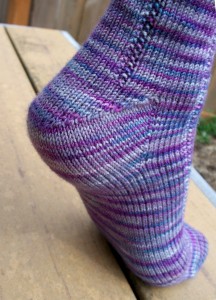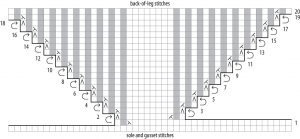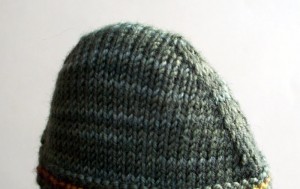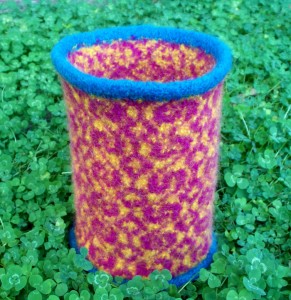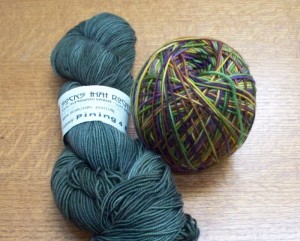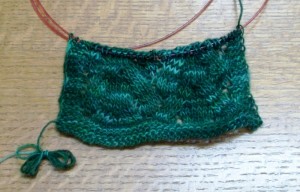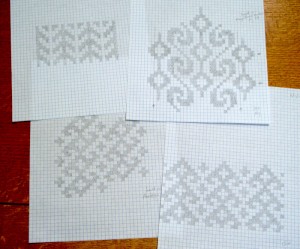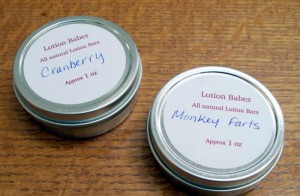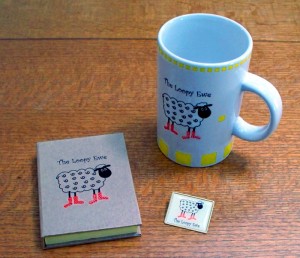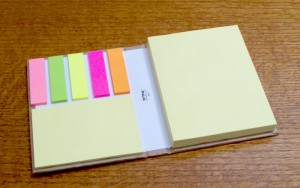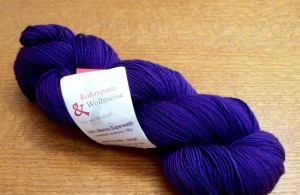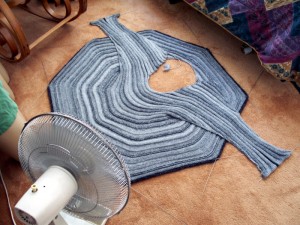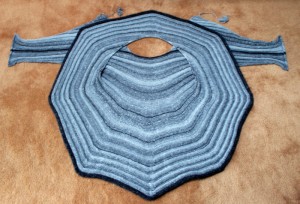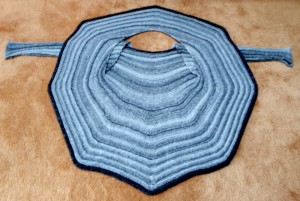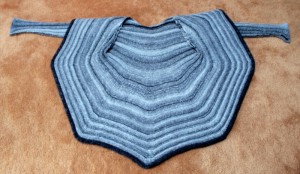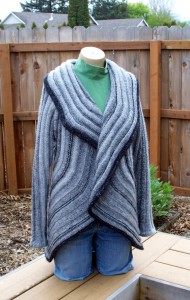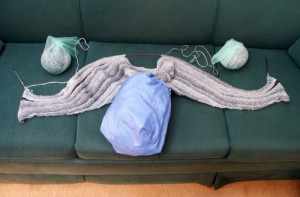Some of you may recall that, years ago, Threads magazine used to include articles on knitting and other fiber crafts in addition to sewing. Fabulous articles, really. Full of inspiration and useful how-to info. My heart sank when Threads decided to focus on sewing only. I mean, Threads is still an awesome magazine, and I can understand why the publishers narrowed its focus. But, jeez, I miss seeing new knitting articles from Threads.
Fortunately, most (all?) of the old knitting articles have been re-printed in a series of compilations. I have ’em all, and frequently tell knitters to search them out. Take this past weekend, for example. Once again, I found myself recommending specific articles… but not remembering which compilation contains them.
I hate it when that happens.
So, once and for all, I’m going to catalog here the names of the compilations, and which ones contain my favorite articles. Not all the articles, mind you (I’m too lazy for that); just my favorites, the ones I like to recommend to people. Maybe the exercise will help me remember which article is in which compilation. If not (and given the kind of trivia that refuses to stick in my head, “not” seems likely), at least now anyone can search this blog for the article names and come up with the compilation names. Sneaky, eh? Okay, here goes:
Great Knits: Texture & Color Techniques:
- “Knit One, Weave Two” talks about dropping stitches to create ladders of loose strands, and weaving fresh yarn into these ladders to create fabric that’s part knit, part woven. I used this technique years ago to create a vest that’s now part of my Hook Hocus-Pocus sample set.
- “Knitting a Basketweave Look-Alike” prompted my first foray into entrelac—I was totally smitten by the article’s feature sweater. It was worked seamlessly, using two green yarns of different textures (rather than two yarns of different colors) for contrast. The article’s author, Gwen Bortner, has since stuffed years of entrelac experience into her own book, Entree to Entrelac.
- “Darts Add Shape to Knitted Garments” is a must-read for every knitter. Lily Chin clearly lays out the whys and hows of both waist darts and bust darts.
- “Knitting with Cotton” suggests tricks for working with cotton yarns—including some stitch patterns that add a bit of “sproing” to the fabric.
- “Handknitting Gloves” by Deborah Newton is jam-packed with info on designing gloves, some using construction techniques I’ve seen nowhere else. Every time I skim the article, I’m enchanted by a pair of red gloves with a small cable running up the cuff and along the thumb, in line with the cuff and thumb shaping. Stunning, just stunning.
- “Fashion Doesn’t Stop at 40 Inches” is another eye-opening article from Deborah Newton. She talks about fitting the fuller figure in the context of sewing fabric mock-ups for two women in particular. Some of this same info appears in Newton’s Designing Knitwear, but for the full story you need to read this article.
- “Knitting Traditions: More than one right way” by Beth Brown-Reinsel is a delight. It shows knitters from around the world, each holding yarn and needles in her own unique way. It was the first resource I ever read that implied there’s no wrong way to knit.
- “Perfect Ribbing for All Fibers” covers a number of techniques. One I use all the time: it’s an alternating cast-on, perfect at the base of double-knitting or a tubular cast-on. Another I’ve been meaning to try for years: a mix of ribbing and double-knitting that’s supposed to create a resilient rib, even when knit out of yarn spun from inelastic fibers.
Knitting Tips & Trade Secrets:
- This last compilation is special. Rather than reprints of articles, it contains a slew of short tips, arranged by topic. I still learn stuff when I leaf through it.
Okay, those are my favorite articles in the Threads compilations. Many, many others are well worth reading too.
Do you have these compilations? What are your favorite articles?
Remember the toe I mentioned in my last post? The one with the kfb increases? It’s turned into a sock:
For the most part, it’s just a plain vanilla sock. The only decorative elements are narrow columns of seed stitch, just two stitches wide, added more to keep me from falling asleep while knitting than for any other reason.
Ah, but the heel—that’s where the real experimentation came in. It’s one of Wendy Johnson’s “gusset heels,” something I’d read about years ago but never gotten around to trying… until now.
And, for me, trying out the heel was essential. Just reading about it didn’t let its construction “sink in” properly. Still, let’s see if I can summarize: For one of these heels, you knit the foot even until you reach the juncture between your foot and your leg… you know, where you get a crease when you bend your foot up. Then you work two gusset increases every other round for a bit. Finally, you work a series of short rows, ending each row with ssk, k1 or p2tog, p1—much like a heel turn on a traditional flap-and-gusset heel—until you’re back to your original stitch count.
In knitting this sock, I wanted to learn two things: How do you know how many gusset increases to work? And how does the heel fit?
As it turns out, I answered the first question not by knitting but by charting the heel turn:
Charting the heel turn let me see that, when you work a bunch of short rows ending with ssk, k1 or p2tog, p1, you’ll decrease away half your stitches—but in the first two rows, you work even over several stitches at the center of the heel. So over the course of the short rows, you’ll lose not quite half your sole and gusset stitches. Specifically, subtract 8 from the number of sole stitches—that’s the number of stitches you’ll lose in the short rows, and the number of gusset increases you’ll need. In my case, the foot had 56 stitches, and the sole had 28 stitches. So I worked 10 pairs of gusset increases, for a total of 20.
And as for the fit? It’s okay. Nice and smooth. But for me, perhaps a little tight over the instep. And for this sort of heel, I don’t yet see a way of changing that. Sure, you could work more gusset increases. But then to decrease those extra stitches away, your first two short rows would have to be shorter, narrowing the tip of the heel. Or your short rows would have to extend into the instep. I think.
I should add that I did veer from Wendy’s original instructions slightly. Instead of working flat until all the gusset stitches had been decreased away, I worked flat until all but two had been decreased away. Then I resumed knitting in the round, working the last two decreases on the first two rounds. You can see this on the chart: I turned after row 18, but then continued in the round. The decreases on rounds 19 and 20 closed the gaps caused by turning at the ends of rows 17 and 18. Nice trick, eh? I got it from Cat Bordhi’s New Pathways for Sock Knitters.
So that’s the experimental sock. I will knit another, to make a pair—I figure it will make for good mindless knitting during Sock Summit.
Toe #4
By JC | July 14, 2011
This past week I’ve been on a sock-knitting kick. This is a good thing: with Sock Summit right around the corner, it’s high time to be in a sock-knitting mood. It all started with a stitch pattern that demanded to be in a sock worked from the toe up. (Sorry, can’t show details; it’s a stealth project.)
Toe #1 was a short-row toe in garter stitch, ’cause I thought the garter stitch would blend well with the rest of the design. Wrong. It was too busy; I needed a plain stockinette toe.
Toe #2 started with Judy’s Magic Cast-on, and proceeded in the usual wedge shape in stockinette. So far, so good: I like the toe. (Not too sure about the heel yet; more on that later.)
Now, my usual rant with sock toes—both cuff-down and toe-up—is that you get a nicer, more rounded toe, without any nasty “ears” or corners, if you vary the rate of shaping. For a wedge toe on a cuff-down sock, I’ll decrease four stitches every other round until half the stitches are gone, then I’ll decrease four stitches every round until the stitch count is cut in half again. In other words, the decrease rate doubles near the tip of the toe. On a toe-up sock, I start with a fast increase rate of four stitches every round, then switch to a slower increase rate of four stitches every other round.
Decreasing every round is easy enough, but increasing every round? It’s a bit of a booger. Lifted increases don’t cut it. And “make 1” increases are fiddly, when you knit your socks as tightly as I knit mine.
So in the past I’ve always resorted to twisted yarn overs: work a yarn over (or a backwards yarn over) on one row, then on the next row twist that yarn over by knitting it though whichever leg is furthest from the tip of the needle. Regular yarn overs twist left, and backwards yarn overs twist right. You end up with increases practically identical to M1L and M1R—as you can see in the photo above—without the fiddliness of picking up a tight little strand of yarn. You do, however, have to keep your wits about you, remembering on which rows to create yarn overs, on which rows to twist, and on which rows to do both. And writing the pattern instructions for such a toe? Not fun.
Which brings us to Toe #3. While skimming through a few resources in search of some heel insight, I spied some some “knit front and back” increases. They’re not my favorite. I mean, in garter stitch they blend in well enough. But I’ve never been keen on having their little bumps show in a stockinette fabric. Still, I had to ask myself: what if I got out some spare yarn, and tried knitting a wedge toe using kfb increases? How bad would it be?
Answer: not bad at all. The bumps line up neatly, forming a nice decorative element—assuming you notice them at all. They aren’t nearly as distracting as I thought they’d be. And they’re super-easy to do. The only catch—and it’s a minor one—is remembering to work kfb into the first stitch and into the next-to-last (not the last!) stitch on both the sole and the instep, so the bumps appear one stitch in from each side of the toe.
So it seems I have a new favorite toe-up toe. And Toe #4 of the week is going to feature kfb increases.
Nadine, you were right: Full o’ Sheep felts up funny.
Despite being a smooth yarn, it produces a surprisingly bumpy felted fabric, as if the yarn were a bouclé. The effect is slightly more pronounced with the yellow yarn—maybe because it was bleached before being dyed, and this affected its ability to felt?
This isn’t to say there’s anything wrong with the fabric. It’s sturdy enough, and the Full o’ Sheep felted easily enough. If I wanted a felted fabric with lots of texture, Full o’ Sheep would be my go-to yarn.
But it’s not quite what I was aiming for this time around. The bumpy, bouclé-like texture is obscuring the colorwork patterning a tad more than I care for.
So, if I were to do this again, I’d pick a bigger, bolder pattern that would show up better even after felting. Or I’d pick colors closer to each other—say, a couple shades of a warm, natural brown—for a subtler effect. Or I’d stick with tried and true Lamb’s Pride, for a smooth felted fabric.
Oh, yeah. And I might felt a swatch before committing to the entire project. Maybe.
But beyond the “could haves” and “should haves,” I still haven’t decided just what this item is. It could still be a bag—I could still punch holes just below the top rim, and thread a cord through for use in closing and carrying the bag. DH says it could be a hat, but last I checked, Dr. Suess still had plenty of hats of his own. A third option: it could be a wastepaper basket. My office could use a wastepaper basket. Or, with a weight in the bottom, I suppose it could be an umbrella stand.
What do y’all think?
Gone
By JC | July 1, 2011
What do you mean it’s July? Where did June go?
Oh, yeah. First there was TNNA, where Sandra McIver’s knit, Swirl! was the hit of the show floor. Then, right on its heels, Knitters Connection. Whew! First time I taught eight classes in the span of four days. No wonder I was exhausted when I got home. But just a few days later it was Black Sheep Gathering, one of my favorite events—this year, we were blessed with near-perfect weather, not too hot and not too cool. And now? Time to prep for Sock Summit!
But I have managed to squeeze in some knitting. The felted bag I mentioned in my last post? Got the knitting done during TNNA; all that remains is the felting. Hmm… The washer’s empty; maybe now’s the time.
And I ripped the lace scarf I’d started. The Malabrigo Lace was screaming for a simpler stitch pattern. So, inspired by teaching Multi-directional Scarves at Knitters Connection, I started a multi-directional scarf. It’s just the basic scarf, composed soley of simple triangles and no diamonds. To hold my interest, though, I’m throwing a few eyelet rows into the garter-stitch base. So far, I’m liking the results.
It looks kind of ratty now, but I’m sure it’ll smarten up with blocking.
Gotta go, July’s going to be over with before I know it…
Searching
By JC | June 9, 2011
Lately, since finishing my Swirl, I haven’t felt much like knitting because… oh, well, your guess is as good as mine. But I suspect it might be this: while I have a handful of WIP I could work on, the very fact that I arguably “should” work on them makes me less inclined to do so. Worse yet, none has a definitive deadline, not in the near future anyway. So the impetus to get crackin’ is missing.
For a while, I tried to be good and finish up existing WIP before starting anything new. That didn’t work; I simply lost enthusiasm for knitting.
So I wound pretty balls of Socks that Rock with the idea of swaching for socks. Lovely stuff. But, nope, that didn’t get me going. Still too close to the concept of “should,” I suppose.
Then, on a whim, I bought a skein of Malabrigo Lace, a yarn I’ve been meaning to play with for some time. I started a scarf, worked a couple repeats of pattern… and set it aside. I wasn’t feeling the love. But I may pick it up again while at TNNA and Knitter’s Connection. Or I may rip and re-start with another stitch pattern.
Still searching for a project with some zing, I figured maybe a change of pace was in order. I pulled out my copy of 1000 Knitting Patterns Book, and swatched Seduction in pattern #760—a crochet pattern. Nice, but not nice enough to sustain my interest.
Finally, while wandering with coupon in hand through the Jo-Ann Fabrics that just opened nearby, I spotted some Full o’ Sheep and an idea hit me: a felted bag. Something knit in stranded colorwork, then fulled. It was perfect: I could go wild with the colors and not worry about the perfection of the stitches. Not caring about the final size or shape of the bag, I could even forgo swatching without too much guilt.
Better yet, it was an excuse to play with charts. I happily frittered away the better part of an evening in leafing through stitch dictionaries and sketching out variations of Turkish-inspired stitch patterns.
Why sketch out so many variations, when I already have folders full of sketches I’ve done in the past? And when the original patterns in the books were just fine to begin with?
Because I felt like it, that’s why. And that was the feeling I’d been looking for.
Who knows? I might even finish this WIP.
In other news, the Loop in London just announced they’ve received shipment of Charts Made Simple. Hurrah to UK knitters! Thanks for your patience!
As I started reading the latest issue of Knitcircus, I thought to myself, “I ought to send them a copy of Charts Made Simple for review.” And then I turned the page and there it was, a review of my book! Sure enough, I checked my records and, yes, I’d sent a copy to Knitcircus a few weeks ago. Duh! Good thing I keep records for this sort of thing…
Thanks for the lovely review, Stephannie!
Not true, of course: I came away from The Loopy Ewe’s Spring Fling with a bunch of surprise goodies. But when I won a “Monkey Farts”-scented lotion bar as a door prize…
…a group of Flingers decided I needed a T-shirt that read “I went to Spring Fling and all I got were Monkey Farts.” I figured a blog entry with that title would be close enough.
Actually, the door prize was a pair of lotion bars.
The Cranberry lotion has a lovely fruity/floral scent with a touch of vanilla. (Or maybe the vanilla is just my imagination, since I love the smell of vanilla.) The scent lingers on my hands for hours.
And the Monkey Farts lotion? No-one that’s sniffed it has been able to figure out what it smells like. Not bananas. Not anything identifiable. Who knows? Maybe it really does smell of monkey farts.
But that’s not all. Everyone that attended Spring Fling received a goodie bag containing Loopy Ewe swag.
Even DH thinks Loopy is pretty darn cute. Myself, I’m particularly smitten by the book of sticky notes.
Is it wrong to get excited over a book of sticky notes? To look forward to marking the patterns in a stitch dictionary with color-coded stickies? I sure hope not.
And—drum roll, please—everyone snagged a skein of Wollmeisse.
Different people got different colors. We were encouraged to trade, but my skein was purple. Who trades away purple? Nobody, I bet. Now I’m just waiting for the skein to tell me what it wants to become.
Of course, the biggest goodie of them all was attending the Spring Fling itself. Sheri, let me say again that you and your elves put on an awesome event. And the Flingers! I don’t think I’ve ever met a bunch of knitters so happy to learn a few cast-on tricks and to knit silly little entrelac samples. I’d come back and teach for y’all again anytime.
Over the weekend, I finished knitting my Swirl—whoo hoo! So Monday morning found me on my knees, threading blocking wires through the edges of a dampened Swirl and laying everything out just so.
Miraculously, despite the wet weather but because of the fan, the Swirl dried in just a day. Then came the seaming.
Here’s how it worked: Picture the Swirl laid out flat, with the sleeves underneath the outer octogon. You’re looking at the insides of the sleeves, the inside of the lower back, and the outsides of the back collar and the lapels.
Note that I left long tails attached to the Swirl when I finished knitting the sleeves. These tails were handy for seaming the sleeves.
With the sleeves folded, it’s easier to fathom how the rest of the seaming works.
See how the selvedges of the sleeve fronts form raglan lines that meet at the back neck? That edge gets seamed to the inside edge of the octogon. You can kind of see it in the next photo, where the collar has been folded back and the yet-to-be-seamed edges have been scrunched up next to each other.
Anyway, after all the origami folding and the seaming, you end up with a Swirl.
I think it looks pretty good on Jane. Don’t you?
I’m seriously tempted to knit another Swirl someday. I have a pile of blue and green yarns of various textures that have been marinating in my stash for years, waiting for just such an excuse to come out and play. I’d probably cast on provisionally for the sleeves, and leave live stitches instead of binding off. Then I could graft along the undersides of the sleeves, eliminating the bulk of a seam. This time, though, I was happy to cast on and bind off normally—it let me toss the Swirl around with abandon, without fear of losing live stitches, as I flipped it this way and that and learned how it all went together… just in time for the Spring Fling.
All week long, I had been dragging on my heels on a task that needed to get done this week. It doesn’t really matter what it was, but it did need to happen today—so I resorted to bribery. I told myself this morning that once I completed that task, I could kick back, watch something from Netflix, and knit on my Swirl jacket. Oh, the decadence! Knitting during daylight hours, instead of waiting until late in the evening, after crossing every other item off the day’s to-do list.
The Swirl jacket, by the way, currently looks like this:
What you see are the backs of the sleeves, and—starting with the bind-off in the center—the fronts of the sleeves and the front neck shaping. The bulk of the sweater (and I mean bulk) is currently contained within a drawstring bag. That bag is proving to be a sanity-saver. When I sit down to knit, I situate the bag on my knees. Then to work a row, I now only need to manage two floppy sleeves and their yarn supplies—the rest of the floppiness is held in check by the bag.
Still, with the week’s dreaded task out of the way, have I fired up Netflix yet? Nope. The sun is shining, and at this time of year in western Oregon, that’s a cause for celebration. I’m feeling guilty for even thinking of staying indoors. Still… maybe I’ll get in an hour of Netflix and knitting before heading outside and welcoming the sun.
Next week: back to the grind, I promise.




